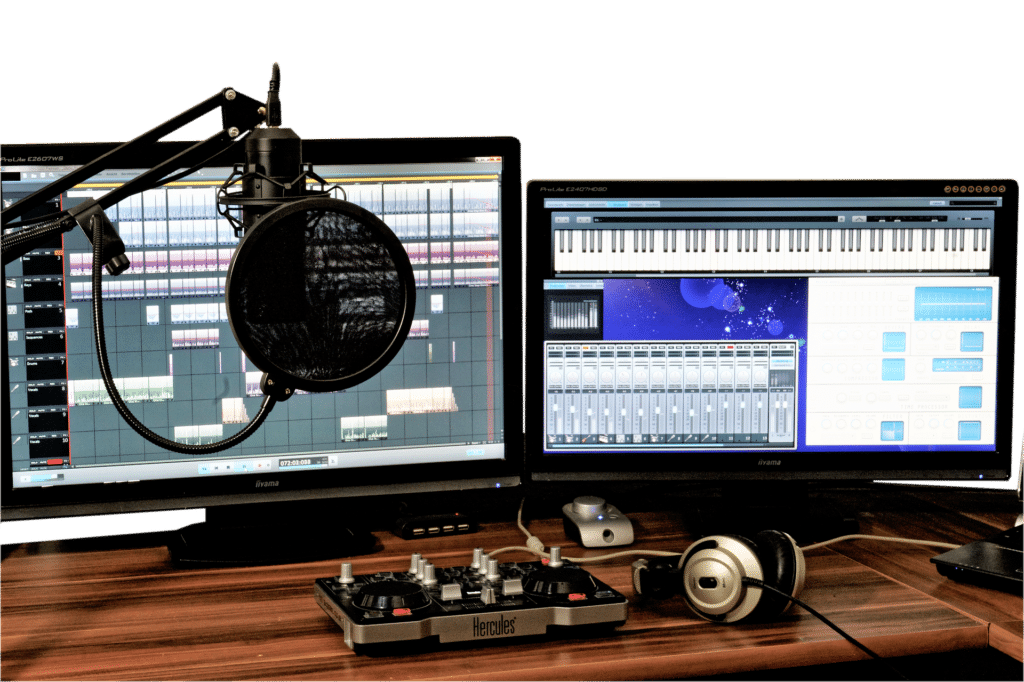Production music, also known as library music, is music that is created specifically for use in various types of media, such as TV shows, films and commercials. Writing production music requires a different approach than writing music for personal use or for live performance. This is because it needs to fit the mood, tone, and pacing of the visual content it is accompanying. In this article, we will discuss some key elements and techniques to consider when writing production music.

Understand Your Target Usage
The first step in writing production music is to understand the requirements for the style of the music. You’ll need to consider the length, tempo and genre of the music. Also make sure you consider the mood and emotion the piece should convey. The quickest and easiest way to get ideas is to simply watch TV shows and listen to the music used. As an example, if you’re writing music for an action movie, you may want to consider using a high-energy electronic or rock genre. Alternatively, if you’re writing music for a romantic comedy, you may want to use a more melodic and light-hearted genre like pop or jazz.
Many Genres Work – Some Better Than Others
There is of course great diversity in shows and movies. This means that production music in almost any genre has the possibility of being licensed. However, there are some genres which will be licensed more frequently, since they are better suited to background music in TV and media. For example, you may find that upbeat, pop influenced music, folk-rock or quirky scene setters (imagine reality TV shows) will perform better than dark ambient or ‘death industrial’ (that really is a genre).
Establish a Rhythmic Foundation
The rhythm and pacing are crucial elements of production music, since they need to match the intended usage. As such, it’s important to establish a rhythmic foundation early on in the writing process. You can achieve this by creating a simple drum beat or a repeating rhythmic pattern. Once you have a solid rhythm in place, you can start building the rest of the musical elements around it. You may even find later on that you can drop out your initial rhythmic pattern, and let the other elements take center stage. The pacing and feel will likely still be there.
Use Simple Melodic and Harmonic Structures
Production music is often designed to be relatively simple and easy to listen to. This is to support the show instead of distracting the viewer. Therefore, it’s important to use melodic and harmonic structures that are not overly complex. This doesn’t mean that the music should be boring or uninteresting, but rather that it should be accessible and easy to follow. Try to keep the melodies and chord progressions straightforward, using subtle variation to keep things interesting. Repetition is acceptable as long as sufficient changes carry the piece and keep it from becoming too robotic.
Consider the Use of Dynamics
Dynamics refer to the volume and intensity of the music. It’s important to use dynamics in production music, as they can help to build a sense of tension, release, and emotion. However, try to use gradual changes in volume and intensity, rather than sudden shifts. This helps to create a smooth and natural progression in the music.
Create a Clear Structure
A clear structure is essential for production music, as it helps to create a sense of order and coherence in the music. It may be best to establish a structure without too many different sections. For example a structure made up of an ABA form. Using a clear structure avoids distracting the viewer. Crucially, it also allows editors to edit the music easily for use in their media projects.
Creating Many Versions of Your Track
Production music often needs to be flexible and adaptable to different uses. As a result, it’s important to write music that can be easily edited and adjusted to fit various scenes and pacing. In reality, the library or publisher will usually require various versions of your final approved track. These can include 15, 30 and 60 second cut downs, as well as stems. Stems are the individual parts of the full song exported on their own. Less commonly, you may need to create loop-able sections. These need to loop seamlessly without pops or clicks. Additionally, you might need to export alternative (alt) versions of the full piece. The idea behind this is to give editors maximum flexibility when using your track in their media productions. This makes it easier for the editor to use your track, and therefore more likely they will license it.
Careful with Copyright
As always, it is very important to avoid using samples which aren’t royalty free. Make sure to purchase a license for the royalty free samples you use and never use them in the “open” (combine with another instrument). This is to avoid infringing copyright, which can of course cause serious problems. Another issue to bear in mind is to steer clear of writing sound-a-likes, even if a publisher requests them. Sound a-likes resemble a well known song, for example a pop hit. This can of course cause problems with copyright.
Conclusion
In conclusion, writing production music requires a specific set of skills and techniques. By learning about the general requirements and in-demand genres, you can create effective and impactful production music that enhances the visuals and engages the audience.
Learn more with our book Make Music? – Make Money!
Check out our videos on production music.